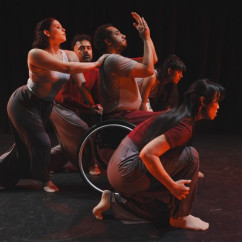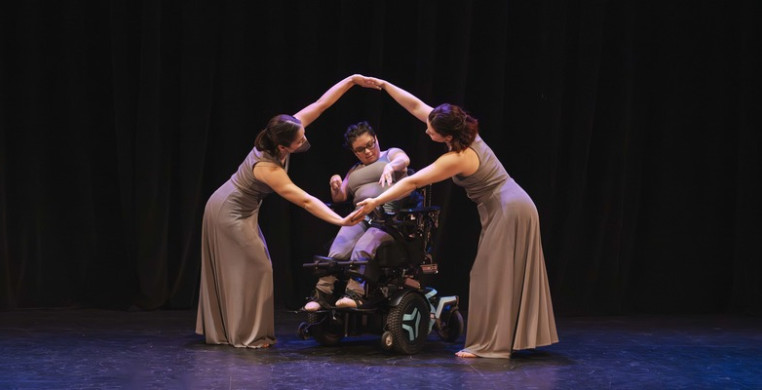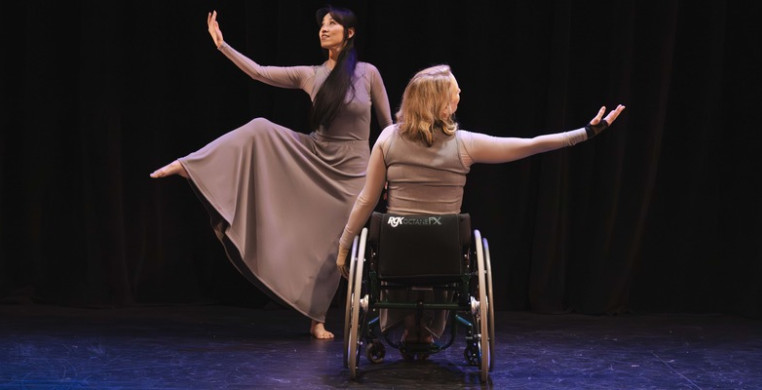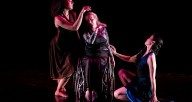UPDATE: The new seechicagodance.com will launch March 31st. Click here to learn more.
CounterBalance: What Is A Dancer Body?
To live in today's world, it’s in your best interest to question why and how you think and feel the things you do. How much was taught versus your own self-discovery? As a dancer and yogi, having lived with folks who have physical and mental disabilities and having artistically worked disabled bodies, I’ve heard them share stories. This discussion continues in "CounterBalance" presented by MOMENTA Dance Company at the Center on Halsted on Oct. 19. Artistic & Executive Director Sarah Najera passionately and creatively bridges misconceptions, preconceived notions and hurtful assumptions on what dancing bodies look like.
"Entwine," choreographed by Sarah Cullen Fuller, is a duet featuring Kris Lenzo and Anita Fillmore Kenny, who weave through one another, even on the ground, with Lenzo guiding his chair with precision. The two different ranges of motion is a meta tone for the night, a celebration of diverse moving bodies.
In "in(Visible) Woman.," choreographer Connor Cornelius uses props to great affect. With undulations and elegant graceful hand movements, soloist Ladonna Freidheim delicately utilizes her arms, fingers and spine. Beside her is a side table with a small lamp turned on. Without connecting physically to the table or lamp until the very end, Freidheim surrenders her upper body to gravity on the table to the sound of gorgeous piano and violin melodies.
“Community Suite: Riding The Waves" by choreographer Robby Williams is a light-hearted piece. To the feel good song “Tuna Turnpike” by Louie Zong, dancers emphasize arm movements to represent animals and sea life living and playing in the tide. As a Cancer, I approve!
 "CounterBalance," with MOMENTA Dance Company; Photo by A.Deran Photography
"CounterBalance," with MOMENTA Dance Company; Photo by A.Deran Photography
In Julia Cox's and Kris Lenzo's “Method,” Lenzo takes to the stage again but for a solo. The spotlight finds him as he’s next to his wheelchair on the ground. Lenzo uses his wheelchair more as a dance partner that performs floor work and lifts as graceful as if a human. When seated, we see side flexions and turns that utilize his palms to the earth. Trusting the wheelchair like a dance partner, he allows himself to fall back but safely make it to the ground.
“(First) Of The Month” by choreographer Abagail Darrow opens with three dancers, one in a wheelchair. They meet with four other ladies and seperate into duets and groups that dance siultaneously. They use lifts, negative space and beautiful hand gestures that create rousing visual effects.
Choreographer and dancer Ginger Lane wasn’t present, but still delighted us with a great performance. “Paloma Triste,” presented as a video projection, shows Lane dancing to a song in Spanish. Under blue and white lights, she smoothly rotates her wrist (reminiscent of Flamenco) while rotating in her wheelchair. Olé!
A narration by Michael Herzovi about Medieval Europe's attitude towards disability introduces Freidheim's "In Response to the Ugly Laws." Dancers Bee Bolino, Tatiana Castañeda and Freidheim embroil themselves in an impersonal story of dealing with the “Ugly Laws”—a municipal ordinance passed in 1881 that prohibited people with disabilities from appearing in public—that existed in Chicago until 1974, which affected Herzovi's teen years. Herzovi sits before us in a wheelchair, wearing glasses and with shortened arms, unapologetically sharing history and his lived experience. Behind him are three women, two in wheelchairs and one in a rolling chair. “Do You Love Me” by The Contours plays as they blissfully shimmy, ripple and hand clap. Disability and happiness are not mutually exclusive—This work is living proof.
 "CounterBalance," with MOMENTA Dance Company; Photo by A.Deran Photography
"CounterBalance," with MOMENTA Dance Company; Photo by A.Deran Photography
Charles Weidman's "Brahms’ Waltzes" (1961) begins with six dancers in gray taking the stage, half are in wheelchairs. To the melody of a piano, duets become solos as dancers enter and exit.The order and pairing seem random and there is no way to know who will dance next, which added a thrill.
In "Can Deaf Dance?," a spotlight shines down on choreographer and soloist Joán Joel dressed in all black. Interpreter Jordan Brown recites a poem written by Jóan Joel about his journey of being a Deaf dancer; Joel simultaneously recites the poem in ASL while dancing. With no music score, the message told both through body and words make the experience highly intimate and clear.
“Symbiosis,” choreographed by Bee Bolino, has a trio entering the space already dancing. The work evolves into duets, solos (at times simultaneously) and group performance. With two in wheelchairs, the choice of when to perform floorwork in and out of the chairs was particularly interesting. The work ends with them forming creative shapes, constructs made from body, rubber and metal.
A duet by Sarah Najera, titled "Nothing Compares," has Julia Cox and Robby Williams, seperated by a brick pillar between them, dancing to “Nothing Compares” by Sinéad O'Connor. The duet is engaging since the pillar prohibits them from ever seeing or touching one another.
Najera's "Light the Flame" closes the show with a group dance that combines ASL interpreting and dance composition. Some of the dancing served as literal translations of the song's lyrics (“Light the Flame” by Takenobu) without coming off as miming or stepping on the interpreter's toes. The use of levels is also fun, going beyond just floor work.
Momenta is at the forefront of pushing audiences to expand what they think about dance. From always having interpreters present (on and off stage), to closed captions on all songs, to considering light sensitivity, no stone was left unturned, and “CounterBalance” truly let this be a space that embraces the disabled community.
“CounterBalance" was presented by Momenta Dance Company on 10/19 - 10/20 at Center on Halsted ,3656 N. Halsted. For more information, click on the company link below or visit momentadances.org.


